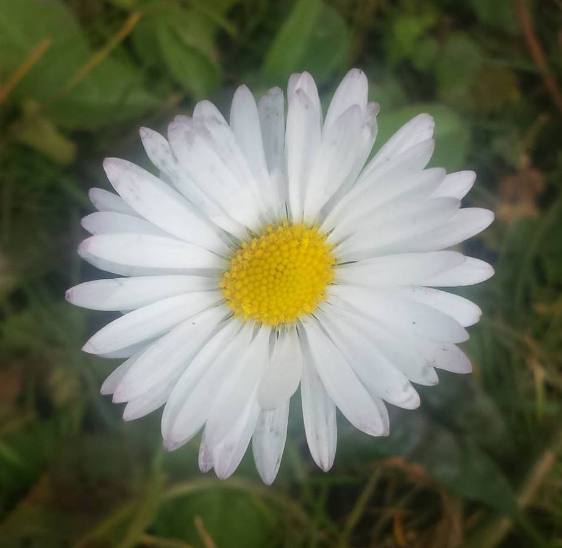Join Nyrees & family of the Wild Wood Emporium on her foraging walk. Create a Journey Stick to remember your travels, and learn which every day plants you find on your walks are edible or medicinal. You can download this guide as a PDF below, and watch the walk on our YouTube Channel (scroll down to watch the video).
What is Foraging?
Foraging is identifying, collecting and eating herbs and other plants that grow wild in nature. You can also use what you collect for food, medicine, fibre and even art.
Why Should Children Forage?
It helps create a connection and understanding between a child and their environment.
Recognizing and providing for themselves using the plants around them can teach children invaluable skills and knowledge, wild edible plants are also very nutritious compared to domesticated crops.

FORAGING TIPS AND GUIDELINES
- Before you go make sure you have bag for collecting, you never know how much you might find.
- Make it clear to the children that they MUST NOT put anything in their mouth without first checking with an adult. Explain that if they eat the wrong thing then it will give them tummy ache. If you are unsure of what something is then take a picture of it and go home and look it up. Before eating you must ensure you definitely know what the plant is.
- You should know which part of this plant is safe to eat, what season to harvest and how it should be prepared. When researching look it up by its Latin name, not it’s common one. This will help you positively identify the plant as common names vary region to region and country to country.
- Ensure everyone is wearing appropriate clothing and footwear.
- Obviously for safety reasons you should avoid foraging near busy roads with little ones. Also picking food here should be avoided because the plant could have been contaminated with pollution from the vehicles. Also be mindful of picking from areas frequented by dog walkers or any other type of pollution.
- Only pick what you need, never strip a plant or bush completely bare, explain to your children that you must leave some food for the insects and animals. Explain also you don’t want to kill the plant and always check if the plant is rare or endangered.
- Work in a holistic way, don’t let the children’s involvement stop at the picking. Get them helping you to cook or prepare your free food when you get home. Then let them eat it, make basic herbal remedies or use fibres and other parts to do arts/crafts.
- It is useful for children to make notes and observations in a wild foraging journal they create themselves.
Journey Stick Activity
Collect memories of your foraging walk to help remember and identify what you found, they can be used to show the path you have walked and also to create something beautiful to show people and tell of your adventures when you get back from your walk.
You will need an interesting stick, some string or wool, then your collected plant material and of course a good spot to go foraging in.
Aboriginal people in Australia used journey sticks as a kind of map so that they could retrace their steps and they also used them to tell stories of their travels when they returned home.
Tie your string to the end of the stick so you have a long loose end which can then be wrapped around the stick to attach the plants as you go.
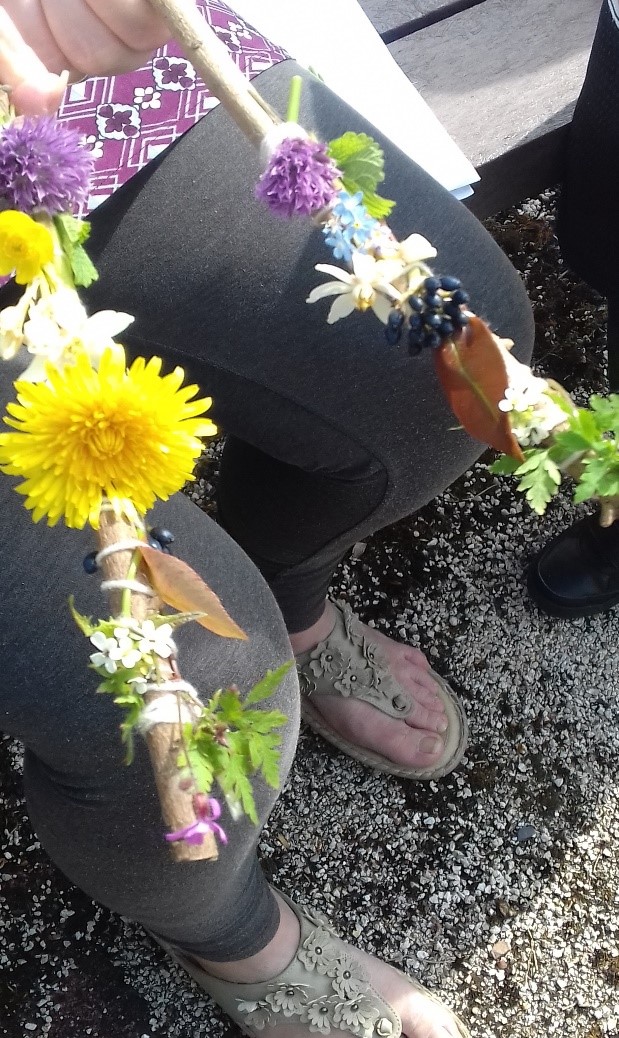
Nettle
Nettles are a very abundant natural resource that are straightforward to identify although painful to collect without gloves.
The Common Name is Stinging Nettle
Scientific Name Urtica dioica.
The Season Starts in January and Ends in December.
Description – The Leaves Green, arrow shaped with very serrated edges, the underneath covered in small stinging hairs with some on top. Growing in pairs on opposite sides of the stalk. The seeds are green and triangular, they have tough erect stems, that are very fibrous and covered in small stinging hairs.
Habitat- Everywhere! It is widespread and particularly abundant on waste ground, hedgerows, woods and cultivated land. Possible Confusion with Dead Nettles from the Lamium family which are edible and although not as tasty they do not sting.
Taste slightly like spinach when cooked but have a flavour of their own.

Blackberry
There are hundreds of different types of blackberry in the UK.
Common Name Bramble, Blackberry
Scientific Name Rubus fruticosus
Season starts in July and ends in September (new leaves can be collected in spring)
Description – Leaves vary from palmate to oval, the flowers are 2-3 cm in diameter growing in clusters, normally with 5 white to pale pink petals but they can have more.
Flower Buds are like little rose buds and the fruit is small and black. The stem is tough and thorny, growing with long feelers across open ground
Habitat – Mixed woodland, hedgerows, railway embankments, waste ground and gardens, it tolerates very poor soil.
Taste Wonderful and sweet, When collecting protect yourself as best you can from the thorns, the leaves can be collected for salads in spring.

Cleavers
Common Names Cleavers, Goosegrass, Sticky Willies
Scientific Name Galium aparine
Season starts in January and ends in December
Description Small, thin, hairy, green leaves growing in small rosettes along the vertical stem. Small round hook laden seeds that will stick to you or your dog if brushed past. Has a square stem covered in many tiny hooks, white, four petalled flowers.
Habitat Hedges, path and roadsides, waste ground and woodland.
Taste/Collection Edible when very young or cooked, if a little fibrous and bitter. Should
be eaten before the seeds appear in summer but can be found all year round. Just the fresh looking tops should be picked or wait until the seeds have fully hardened, roast and use as a coffee substitute.The leaves can be collected for salads in spring.
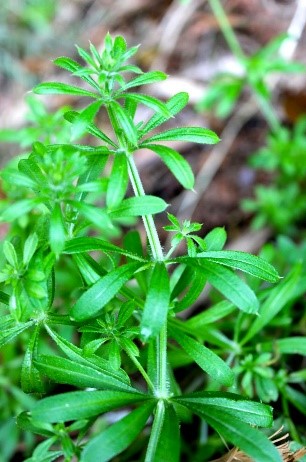
Woundwort
Common name Woundwort, All Heal
Scientific name Stachys sylvatica
Season Starts in April and ends in November
Description A tall hairy perennial that where its tall spires of crimson-purple flowers stand out among the lushness of green growth of other plants. The flowers are arranged in whorls around the central stem. They are hooded, with the lower lip variegated with white against the crimson background. Bees love this plant and are frequent visitors. The whole plant has a fairly pungent even foetid smell, which is not particularly pleasant. It has dark green pointed-oval leaves that are stalked and toothed. It has a square stem, though this is solid and full of pith, not hollow.
Habitat Hedges, woodland and on waste ground.
Collecting/Taste Not edible however as its name suggests it has been used as a wound-healing herb and enjoyed quite a reputation in the past as its other name All heal, suggests. An ointment of Woundwort can be used for all cuts and scratches.

Jack in the hedge
Common names Hedge garlic, Jack by the Hedge, Garlic mustard, Poor mans mustard
Scientific name Alliara petiolata
Season Starts in January and ends in December
Description Hedge garlic is biennial and in its first years growth the leaves grow in a small, ground level rosette with broad heart shaped leaves. In its second year a spike grows from the rosette and the leaves are more arrow head shaped with serrated edges. Groups of tiny, white, four petalled flowers grow from the top of the flower spike. Mild garlic smell when crushed.
Habitat Hedgerows, woodland, shady scrub and path edges.
Collecting/Taste Mildly garlic with a hint of mustard, Collecting The young first years leaves or from the top of the plant in its second year are best and along with the flowers and flower buds help make an attractive and tasty salad. The seeds can be used as mustard. The roots at the end of the second years growth taste like mild horseradish. The plant contains a natural antifreeze so the over – wintering rosette can be and eaten even in the depths of winter.

Himalayan Balm
Common Names Himalayan Balsam, Policeman’s Helmet, Bobby Tops, Copper Tops
Scientific Name Impatiens glandulifera
Season Starts March to the end of November
Description The leaves are Lanceolate with red veins and serrated with a red tinge at the edges. Flowers are different hues of white, pink and purple and very ornate with a hood like shape. Seed pods The explosive seed pods are thinly kite shaped and green with red veins. The seeds start off-white becoming black and eventually very hard. The stem is pale green to yellow, hollow, smooth and hairless with a red tinge. When mature the seed pods are under a substantial amount of tension and the slightest touch will cause them to jettison their seeds up to seven meters away from the parent plant making this a flourishing coloniser of the British countryside.
Habitat –Along riversides, streams, ponds, lakes and damp meadows or woodland.
Frequency becoming more common alongside British waterways every year, it is considered an invasive species.
Collecting/Taste-The young leaves are best for salads, the older leaves can be used in soups and stews and the flowers can be used in salads. The young leaves have a neutral taste, the older leaves can be a bit bitter and the seeds have a pleasant nutty taste.

Hawthorne
Common Names Hawthorn, May, Maythorn, Whitethorn
Scientific Name Crataegus monogyna/laevigata
Season Starts in March and ends in November
Description Leaves are deeply lobed and a bit darker green on the top surface of the leaf. The flowers Small, white, with five petals and an almond smell. Flowers from May to June.
Fruit orange to deep red berries, typically with one stone although there can be more in some species or hybrids, hang in clusters in the Autumn.The smaller thin branches have very sharp thorns. Older mature Hawthorns are more like trees than shrubs and have gnarled, twisted trunks.
Habitat Hedgerows, woodland, waste ground and planted in urban areas.
Frequency Common.
Collecting/Taste The leaves can be collected in Spring for use in salads or at any time for teas. The petals can be used for salads. The flowers have a bitter almond or marzipan smell. The berries taste a bit like a slightly over ripe apple. The berries are best after a frost in Autumn but as frosts appear later and later try the berries, they are ready when sweet and mostly used in jams.

Dandelion
Common Names Dandelion, Dent-de lion, Piss-en-lit
Scientific Name Taraxacum officinale
Season Starts in January and ends in December
Description Leaves Green, heavily toothed edges and growing in a rosette. Exudes a milky sap when cut. The flowers are quite large yellow flowers made up of many fine, long, thin petals turning into the well-known sphere of seed parachutes. Flower Stem Long, thin and hollow stem for the flower, the leaves have no stem and grow from the base of the plant. Everybody knows the Dandelion clock of seeds. These can travel long distances to spread to almost anywhere. It has a large tap root, carrot shaped. Cream to pale brown.
Habitat Pasture, fields, hedgerows, gardens, roadside, woods and waste ground, pretty much everywhere.
Possible confusion with Cats Ear, Hawkbit or Goats Beard but they are all edible.
Collecting/Taste . Only the younger leaves should be consumed. The root can be dug up and roasted. The dandelion has many food uses such as salad, a green vegetable, a flavouring for soft and alcoholic drinks, a substitute for coffee.
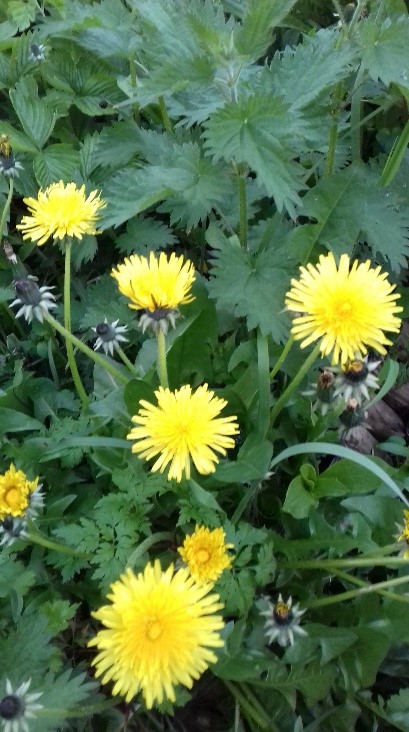

Clover
Common Names Clovers, Trefoil, Red Clover, Hares Tail Clover, Dutch Clover, Swedish Clover, Hop Trefoil, Meadow Clover
Scientific Name Trifolium sp
Season Starts in January and ends in December
Description There are three leaves opposing each other on one stem. Occasionally four, five or even more leaves can be found but this is rare. The individual leaves are green, generally oval shaped, sometimes with a point at the end and can show variegation.
Many clovers have a ‘ball’ of small tubular flowers that are pink, red/purple or white, some have yellow flowers and there are few others and hybrids within the species.The tiny seeds or ‘peas’ are found at the base of the flowers.
Habitat Grasslands including gardens, verges, pastures, fields, parks and waste ground.
Frequency Common.
Collecting/Taste The leaves have a grassy taste, the seeds taste like peas and the flowers, depending when they are picked can be quite sweet.
The leaves are edible but too many can cause bloating.

Plantain
Common Names Ribwort Plantain, Narrow Leaf Plantain
Scientific Name Plantago lanceolata
Season Starts March and ends November
Description The leaves are long, narrow, lanceolate shaped and have veins (ribs) running parallel from the base of the leaf to the pointed top. The flowers grow from a stubby brown inflorescence on a leafless flower stalk and are tiny and white and can be found throughout Summer. The flower stem is square in profile and can be quite hairy.
Habitat Fields, lawns, meadows, roadsides, waste ground, parks and even sand dunes. It is a very hardy plant and can usually be found in any environment with soil.
Frequency Very common.
Collecting/Taste The leaves, like Common Plantain, are too bitter, even when young but the ‘bud’ on the flower stem tastes surprisingly like mushroom.
The leaves can be collected at any time for medicinal use, the flower ‘buds’, if being used to make a mushroom stock, need to be collected after they have turned brown but
Plantain is very effective at dealing with nettle stings or insect bites/stings unlike Dock which is just a placebo but if your children get stung and you can’t find any Plantain, placebos work! The leaves can also be used to make a tea that acts as an effective cough medicine.
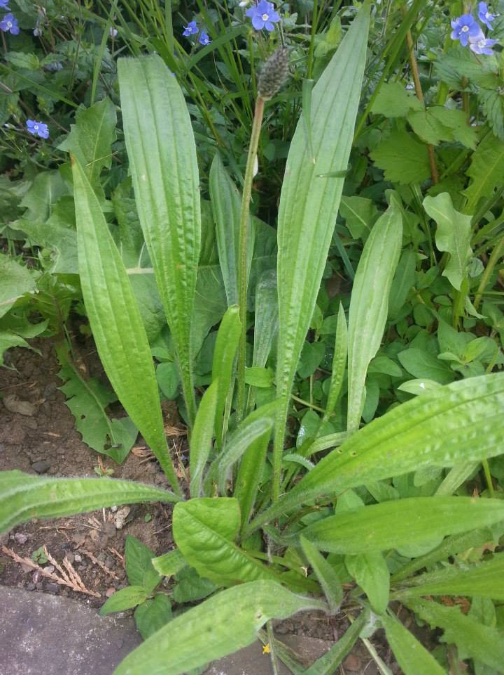
Greater Plantain
Common name Greater plantain, Broad Leaf Plantain, White mans foot, Englishmans foot
Scientific name Plantago major
Season Starts March and ends November
Description The leaves are broad, oval shaped and grow in a rosette, sometimes with very fine, sparse, white hairs. with no true stem but the flower stem is tall, thin and covered in flowers or seeds. The parallel veins are very distinctive in the plantain family and run from the bottom of the leaf to the top. The many flowers are tiny and green to yellow/white, growing on a tall thin flower spike. Each plant can produce thousands of seeds.
Habitat Fields, lawns, roadsides, waste ground, parks and disturbed ground. It is a very common hardy plant and can usually be found in any environment with soil.
Collecting/Taste Even the young leaves of this plant taste bitter to us, it is best used as a medicine. The young leaves are what you are after if there is nothing else to eat or the seeds are relatively easy to collect if a little bitter.

Daisy
Common Names Daisy, Bruisewort
Scientific Name Bellis perenis
Season Starts in January ends in October
Description small, dark green, rounded or spoon shaped leaves that can be hairy.
Many white petals around a yellow collection of sessile yellow flowers. A thin, hairy, green flower stem with no leaves.
Habitat Lawns, meadows, fields, parks, woodland clearings and roadsides. Daisies are easy to identify and they are easy to find. Frequency is prevalent.
Collecting/Taste A bit medicinal, The leaves and flowers can be collected for use in salads. Medicinal Uses An extract of daisy used to be used to help heal wounds.
Other Facts The name Daisy appears to have come from ‘days eye’, as the flower opens at dawn and shuts at dusk.
